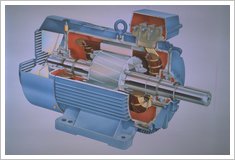Unbalance phase voltages on a three (3) power system produce negative sequence components of the voltage. Even a small voltage unbalance will result in large current unbalance during the running of the motor by a factor of 6 to 10 times.
The effects of unbalance voltages are:
- Negative phase sequence components causes motor overheating;
- Negative phase sequence currents reduce motor output torque;
- Motor runs at higher slip increasing rotor loss and reducing efficiency.
This is one of the reasons why in a three(3) phase distribution design, single-phase loads should be distributed evenly on each phase. Unbalance single load distribution creates unbalance phase currents. The unbalance currents produce unequal voltage drop on each phase conductors leading to unbalance voltages on the load terminals.
Electrical engineers should always consider balancing single-phase loads evenly across all phases when doing load distribution as voltage unbalance affects considerably the efficiency of induction motors which will affect the overall efficiency of the power system.
On a brownfield project where load balancing is beyond the electrical engineer's control, using a motor protection relay with phase unbalance protection is recommended. Most particularly for critical operations. Motor protection relays are not so expensive now unlike 2 or 3 decades ago thus it will be more economical to install motor protection rather than tinkering with the balancing existing loads. Motor protection relays phase unbalance setting, depending on the make and model, can be set from 50% to 90% range with default at around 90% for alarm and around 85% for trip.
To avoid a motor failure by phase unbalance, the protection relay calculates a ratio between the lowest phase current to the highest phase current (ILmin/ILmax) from the measured currents of all three phases. If the condition set by this parameter is true, there will be an Unbalance alarm warning message. The unbalance alarm clears automatically after normal status is attained after a preset time of approximately 10 to 60 seconds depending on the desired level of protection.

Comments are closed.